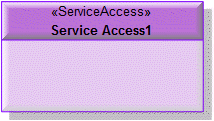Service access (UPDM - DoDAF aliases)
Creation
To create a Service Access:
Appearance
Relationships
The following relationships are of importance to a Service Access:
• Forecast relationships link a Service Access to forecasted future Service Access elements.
The following sections provide information about how a Service Access is used in the model.
Create a Service Access from
Create from a Service Access
In addition to the UPDM elements that can be created from all UPDM elements (
Representation ,
Definition ,
Information , and
Metadata ):
Shown on these diagrams, tables and matrices
In addition to the
AV-2 Integrated Dictionary and
StdV-1 Standards Profile , which can show all UPDM elements:
UPDM writeable properties
The following writeable properties are available on the Service Access tab of a Service Access element's Property Pages:
•
•


 Service Access toolbar button, and then click in free space on the diagram.
Service Access toolbar button, and then click in free space on the diagram.
